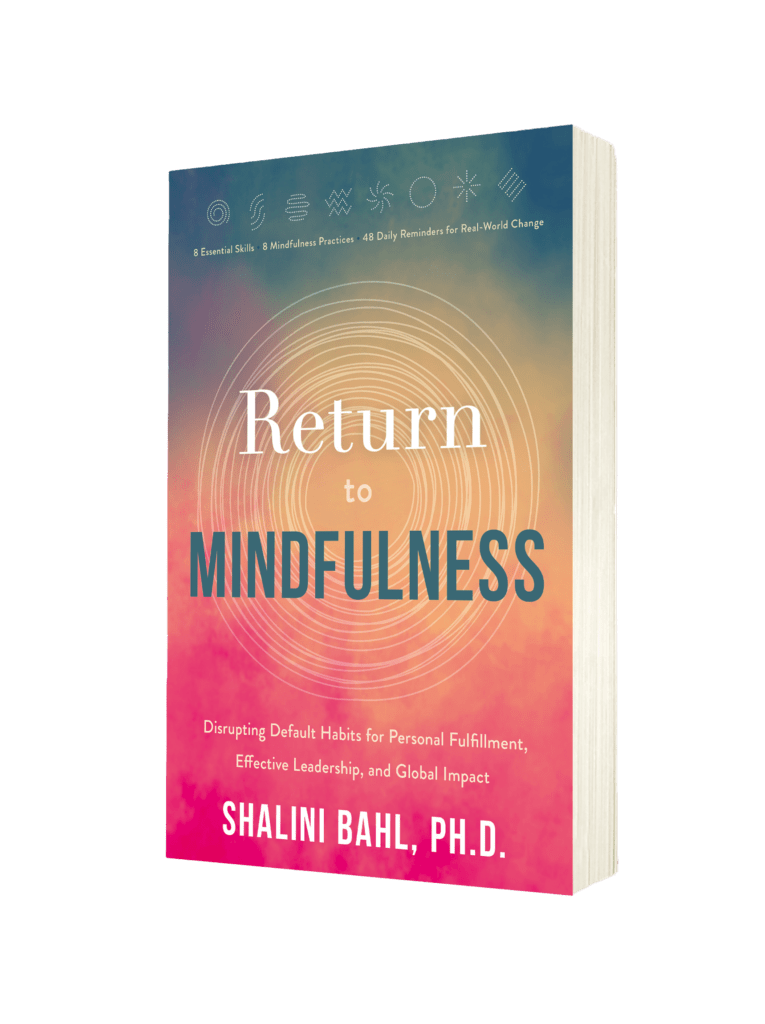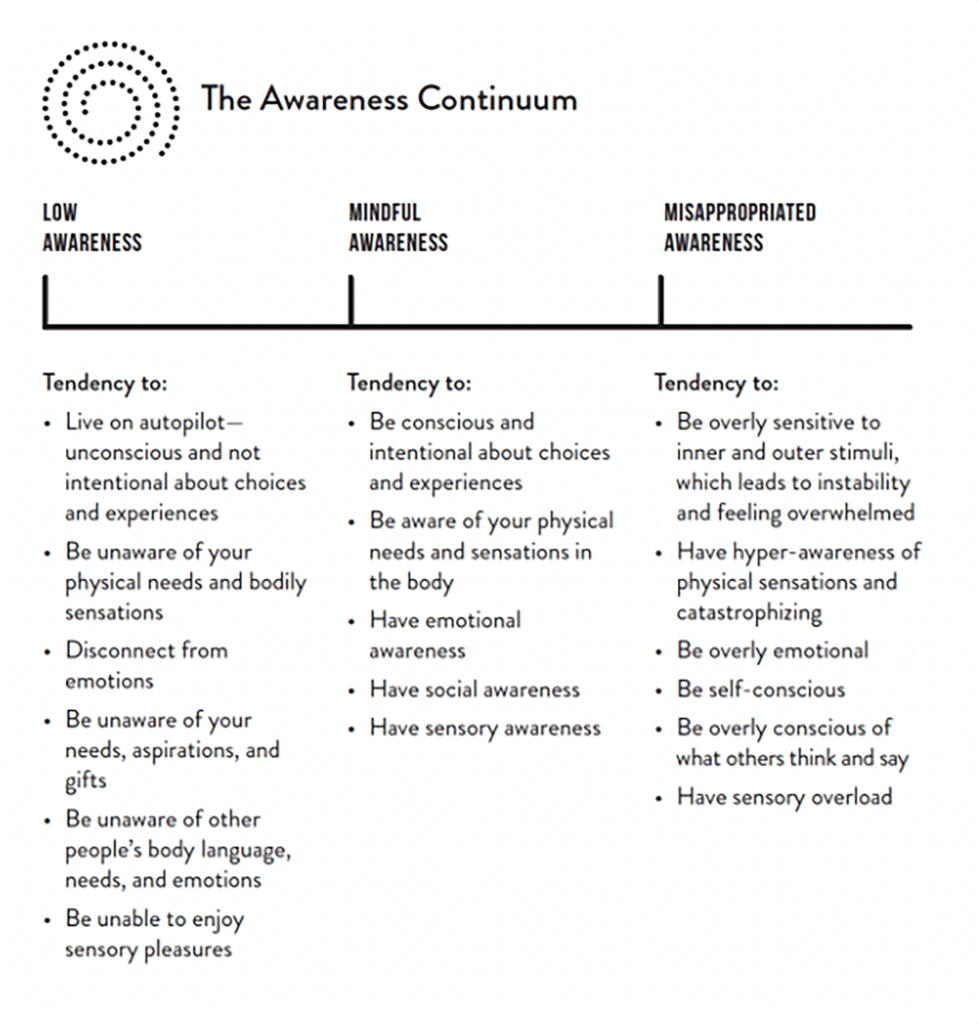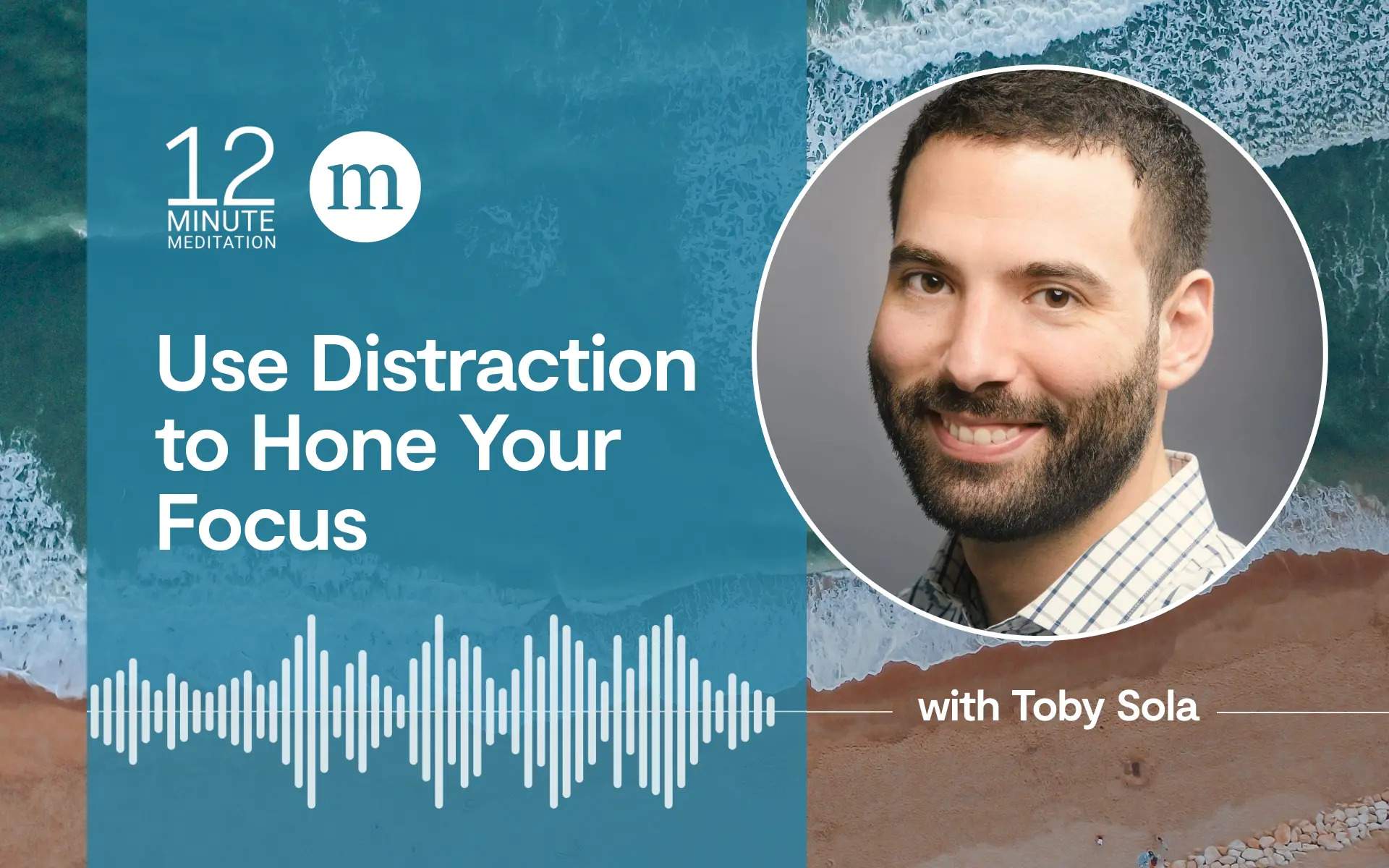Awareness is our capacity to observe without judgment what’s happening in the outer world and inner self; this includes our body, feelings, thoughts, habits of the mind, and what we value. For instance, as you bring awareness to these words you’re reading, are you also aware of your breath moving in and out of your body? Is your body posture supporting you in being alert and relaxed? Perhaps you notice a tightness in your body, and your breath is shallow. Now that you’re aware of your breath and body, you can soften places that are holding tension and allow your breath to go a little deeper. By returning to your awareness, you can break the autopilot habit and gain more control over how you respond to situations. You’re taking back ownership of yourself.
While it may be easier to live using our default settings to react to life automatically and unconsciously, this approach deprives us of the power to choose how to think and what to pay attention to.
Even though awareness is an innate ability, we forget. We let the momentum of our habits and circumstances take over our lives. David Foster Wallace’s commencement speech, “This Is Water,” delivered at Kenyon College, depicts our disconnect from awareness with a story of fish swimming in the ocean. An older fish greets two young fish, “Morning, boys! How’s the water?” and one of the young fish turns to the other one and asks, “What the hell is water?!” But just like fish fail to see the water they swim in, we, too, are not aware of who and what is before us. We live disconnected from what is, sometimes, most important and from each other as human beings. While it may be easier to live using our default settings to react to life automatically and unconsciously, this approach deprives us of the power to choose how to think and what to pay attention to.
To reliably reconnect with awareness in the middle of life, it’s essential to recognize the different pathways that lead back to this innate capacity—inner or outer awareness, sensory or cognitive awareness, and meta-awareness.
Inner vs. Outer Awareness
Inner awareness is our ability to sense and know what’s happening within us. The faculty of inner awareness empowers us to recognize our body sensations, thoughts, feelings, judgments, preferences, and values. For instance, when we’re triggered, our heart beats faster, our breathing becomes shallow, and our shoulders tense. Internal awareness helps us understand the causes and conditions of our reactions. Sometimes we don’t uncover what’s bothering us right away. That’s why we develop other mindfulness skills to accompany our awareness.
The more masterful we become at observing our inner and outer landscape, the more choices we have to respond in skillful ways, no matter what life throws at us.
Outer awareness includes not only what’s plainly visible but also subtle changes, movements, and patterns of behavior in people around us. It’s possible we’re so lost in inner awareness that we don’t notice the body language and feelings of our children, partners, or colleagues at work. We also need to be able to notice the changes in our environment—such as new technologies, political unrest, climate change, and social movements—so we can adequately adapt, respond, and, when necessary, lead the change.
As such, we need to strengthen inner and outer awareness. As we refine our ability to notice more nuanced feelings and sensations within ourselves, the more we can direct our refined awareness toward happenings in the external world. The more masterful we become at observing our inner and outer landscape, the more choices we have to respond in skillful ways, no matter what life throws at us.
Sensory Awareness vs. Cognitive Awareness
Unlike our thinking mind, which plans, remembers, and pursues cognitive tasks, sensory awareness allows us to experience the present moment through sight, smell, touch, or taste in a way that refreshes rather than exhausts. So, in those moments when mental fatigue hits, turn down the thinking volume and indulge in a bite (or two!) of dark chocolate, feel the warmth from your morning cup of joe, and soak up some sunshine. Allow yourself moments like these throughout your day—as they provide tremendous relief for both mind and body and strengthen your ability to return to mindfulness in the middle of life.
Neuroscientists have discovered an important truth: Thinking and sensing are very different activities that can’t occur concurrently. So, we can’t think and sense at the same time. Why is this important? Sensory awareness is a quick way to get out of our heads and return to our awareness of the present moment. It’s all too easy to become trapped within our minds—ruminating over past misfortunes or worrying about future anxieties—that we miss out on some of the most beautiful moments this world has to offer: birdsong as it drifts across an open sky, winter days with their soft sunlight, a blanket of white clouds across an azure sky. These are all occasions that offer much-needed respite to our nonstop thinking, rushing, and striving. Intellectually we know all this. Yet, it’s hard to disrupt the momentum of habits that we’ve picked up along the way and seem to have a mind of their own. This is where meta-awareness comes in.
Meta-Awareness
It is the nature of the mind to be distracted, and we also have the capacity to know that we’re distracted. This capacity to know the contents of our mind and habits of the mind is meta-awareness. It is what makes it possible for us to know that we’re distracted from what’s important in the present moment. Like right now, even as you’re reading this book, are you aware of all the thoughts in the last few minutes that hijacked your attention—maybe thoughts about an email you need to send, something your partner said earlier today, or the molten chocolate cake in your fridge that will go well with coffee as you read this book? Okay, so the last example wasn’t entirely made up. Anyway, the point is that we have developed habits of the mind that leave us distracted and disconnected from what gives us joy and meaning. Meta-awareness is our capacity to recognize these habitual patterns and return our attention to what fulfills our lives in general or at any given moment.
Meta-awareness is our capacity to recognize these habitual patterns and return our attention to what fulfills our lives in general or at any given moment.
Meta-awareness can also help us regulate the contents of our thinking. When we find ourselves drifting toward thoughts and behaviors that aren’t aligned with our intentions, this meta-awareness can guide us back on track, prompting actions in alignment with our goals. At the same time, it’s important to note that not all mind wandering is bad. In fact, mind wandering has been associated with creativity. When we allow our minds to wander freely, unencumbered by stress, we make unconscious connections that can lead to novel solutions. But we need to know when to allow for mind wandering and when to be present. Meta-awareness empowers us to make that choice!
Awareness makes us masterful at observing our inner and outer worlds, sensory and thinking worlds, and how our minds work. Awareness is a foundational skill that empowers us to be mindful in the real world, especially when we want to bring change in ourselves, our families, our organizations, or within communities.
Where Are You on the Awareness Continuum?
Before we dive into ways to deepen our connection with awareness, take a few moments to reflect on your capacity for awareness—inner and outer, sensory and cognitive, and meta-awareness. You can also take the mindfulness assessment on my website (KnowYourMind.training) and use the report as a contemplative tool. The results are not intended to create judgment or get overconfident about your ability to live with awareness. We all have an innate capacity to be aware, and the question is, are you able to bring awareness in situations that matter to you?
Take a look at the Awareness Continuum table to reflect on the benefits of awareness and your tendencies. See the impact when awareness is mindful, when it’s low, and when it’s misappropriated by other qualities of the mind that are disguised as awareness and get in the way of being mindful.
A Mindfulness Practice for Open Awareness
The metaphor of a flagpole may be helpful here. Your awareness is like a flagpole, and your mind is like the flag, fluttering in the wind. No matter how stormy the weather, the flag doesn’t fly away because it’s anchored to the pole. Similarly, by strengthening your connection to awareness, you’ll learn to weather all kinds of storms with stability and grace. You can bring awareness to your breath, body sensations, sounds, other sensory experiences, thoughts, emotions, and your moment-to-moment experience. The practice of open awareness prepares you to meet all of life with fresh eyes.
I recommend doing this brief practice once per day.
1. Start by returning to your awareness of the breath as an anchor to the present moment. Once your attention is stabilized, you can open your awareness to body sensations, sounds, thoughts, and eventually to your moment-to-moment experience—allowing all sensations to arise and dissolve in the vast sky-like quality of your open awareness—not resisting or clinging to any experience. Simply be with whatever arises in your experience.
2. Take a few moments to listen to any insights about your capacity for awareness. If it’s helpful, use the following questions for contemplation or journaling:
- What did you discover about the quality of your mind and ability to be present in your moment-to-moment experience?
- What are the causes and conditions that support your awareness, and what gets in the way of being aware?
- What are your intentions for cultivating awareness?
3. Integrate your insights and intentions related to awareness before you begin your next activity. See if you can return to awareness of your thoughts, speech, and all actions and interactions.
Excerpted from the book Return to Mindfulness: Disrupting Default Habits for Personal Fulfillment, Effective Leadership, and Global Impact by Shalini Bahl Milne. Copyright © 2024 Shalini Bahl Milne. Republished with permission from the author. Return to Mindfulness will be available on Amazon on January 18, 2024.









